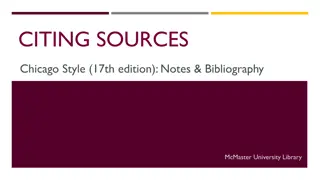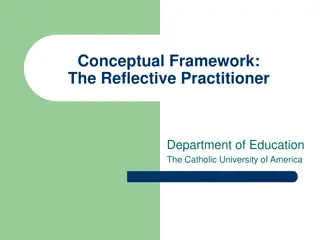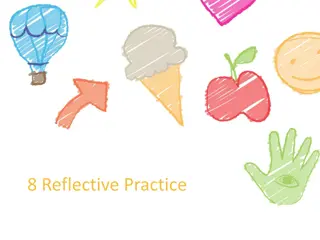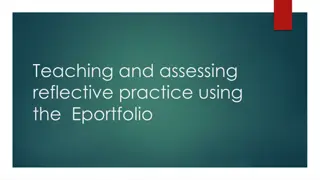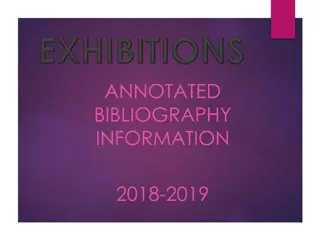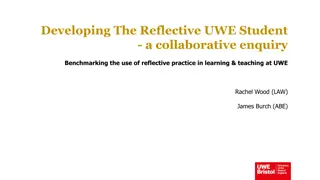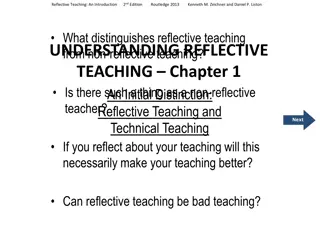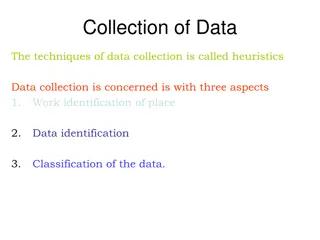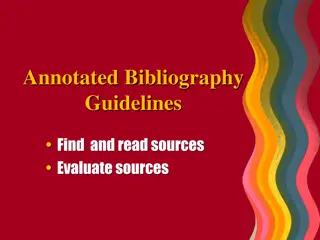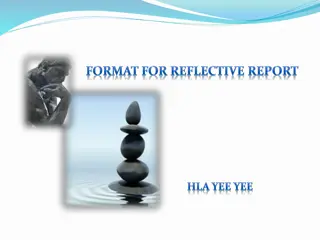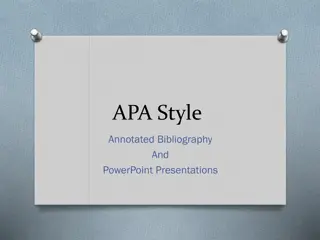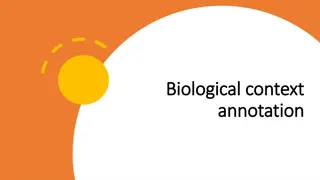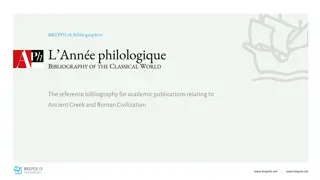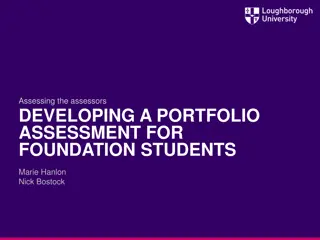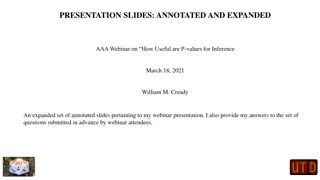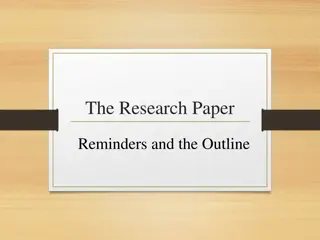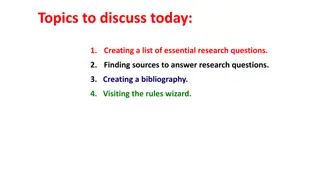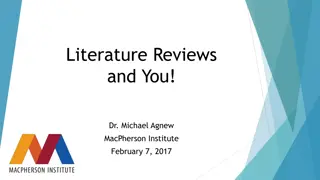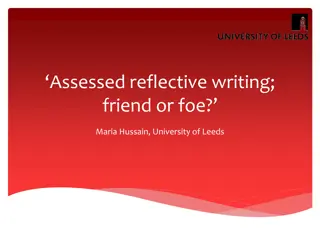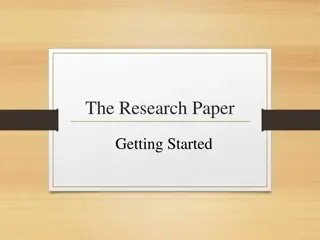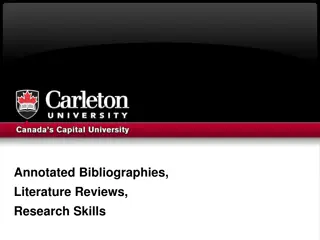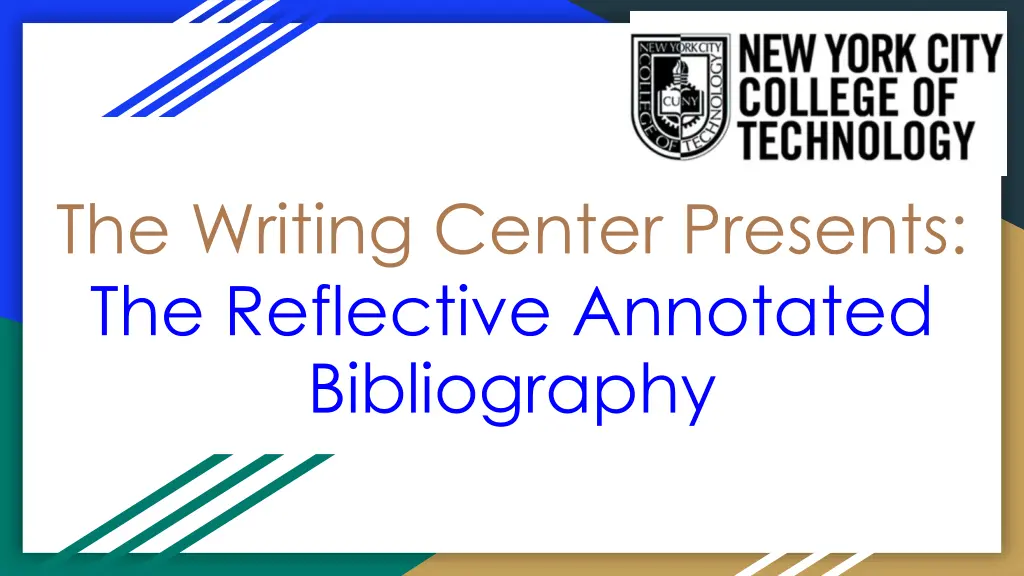
Understanding Reflective Annotated Bibliographies
Learn about Reflective Annotated Bibliographies (RAB) and how they are used to analyze and summarize sources closely, aiding in understanding various topics. Discover the importance of RABs, what they entail, and what they are not. Dive into the world of analytical annotated bibliographies with this comprehensive guide.
Uploaded on | 1 Views
Download Presentation

Please find below an Image/Link to download the presentation.
The content on the website is provided AS IS for your information and personal use only. It may not be sold, licensed, or shared on other websites without obtaining consent from the author. If you encounter any issues during the download, it is possible that the publisher has removed the file from their server.
You are allowed to download the files provided on this website for personal or commercial use, subject to the condition that they are used lawfully. All files are the property of their respective owners.
The content on the website is provided AS IS for your information and personal use only. It may not be sold, licensed, or shared on other websites without obtaining consent from the author.
E N D
Presentation Transcript
The Writing Center Presents: The Reflective Annotated Bibliography
Checking in Who s working on an annotated bibliography, also known as the RAB? What questions do you have? What s confusing you?
What does RAB stand for? Reflective: Looking at something closely to see what it is and how it works including things we ve done! Annotated: Annotate means to mark. We annotate mark up something so we can think more carefully about it. So we can explain it. Bibliography: Comes from Latin biblio meaning books, and graphia meaning writing. So it s writing down about books. It has come to mean a list of books and other materials. Why do we use annotated bibliographies? To save us a whole lot of time and aggravation!
Annotated Bibliographies Metri, Angela Elizabeth. The Importance of Design. Medium, Medium, 9 July 2019, https://medium.com/@aemetri/the-importance-of-design-187c3ce45961 The article contains basic information to introduce people to design. It gives information about how design has evolved throughout the years with different companies attempting to master their brand design for the industry. For example, designers developed infographics to make it simple and easy to understand what they want to convey. These came from basic sketches and drawings used to create a new language without using words. The article also says that one way to know how to understand what design is by learning the technical side behind it. The easier it is to use a design, the better the design. If the design is bad then that means we wouldn't be able to use it as easily. That's the very basis of how the eye can distinguish a good and bad design. This article was published in 2018 which isn't that long ago and still is relevant since it talks mostly about the general history and what design is on paper. Medium.com is a known platform where people are allowed to post essays or blogs about whatever topic they want. Some are written by professionals and others are written by normal people wanting to express their opinions. The author of the article is a writer but although they aren't a designer themselves, they stated the sources used to speak about what design is in their essay. I would use this info to simply state the basics about design and to introduce the audience to what I will be speaking about.
So what IS an RAB? It is an analytical annotated bibliography. A list of books and other sources/genres that we summarize and then examine more closely in terms of audience and author and purpose so that we can really understand how each source works to create its message... so we can learn something new about an issue we re curious about or a question we have.
What the RAB isnt A persuasive paper where you take a position and proving it. An RAB starts with questions instead of answers - it s about curiosity! High school academic research report. An RAB is information gathered for a larger purpose (curiosity!) Library only research. An RAB asks you to look everywhere! Peer-reviewed journal articles in the library Credible websites and news organizations Credible videos and podcasts Interviews and field work that you do
The RAB Assignment (briefly) Introduction Source Analysis of three sources in different genres Bibliographic information Summary 2-3 key quotes Rhetorical analysis Optional: reflection Conclusion/Reflection
Introduction Introduce your question/topic. Explain why it interests you. Tell us what you wish to find out more about. Get curious! This part is personal so you can use I it s your topic! (you can even think of the introduction as your proposal or your proposal as your introduction )
An example of a proposal/introduction Black Holes Space is something that has always interested me throughout my life. When I was a kid I would always go out and stare at the stars, wanting to be an astronaut. As I got older, I would learn more and realize just how little we know about the universe. One of the biggest examples of this would be our understanding of black holes. Black holes are one of the most mystifying things we ve ever encountered, often becoming the most entertaining part of sci-fi and space movies/books/comics/games. Movies like Interstellar and people like Stephen Hawking have recently popularized the topic in the past 15 years. I ve always had preconceived ideas of how black holes appear and disappear, but I ve decided to now learn what the actual science is behind it, expecting to find a lot of different theories and learn information I ve never expected, including whether we should worry about them having an impact on our planet.
Source Analysis Bibliographic information One-paragraph summary 2-3 Key Quotes One-paragraph rhetorical analysis (author, credibility, context, use of language, use of visuals) Optional: Reflection of what you think about the article. The word I does not appear anywhere in a source analysis unless you re adding your own personal reflection about each source.
Conclusion/Reflection Briefly summarize what you learned from doing this research. What surprised you? How did your thinking on the question/topic deepen or change? What happened to your initial question? What do you think about these ideas (time for your own ideas!)? Do you think the authors supported their ideas well and made their point, or not, and why (Avoid simply agreeing or disagreeing with the author; explain your full reaction. Quote particular sentences to which you are responding.)? What questions do you have about what the author said? What don t you understand? What other information do you need to (or did) look up to better understand this source? If you could say something to the author(s), what would you say? Which genres worked best to answer your questions? Why? Talk about why you think what you learned is important, who you think should hear about it.
Example of conclusion/reflection I already had previous knowledge when it came to the creation of black holes and supernovas, however, when it came to the disappearance of black holes that surprised me. I ve always heard of Stephen Hawking but I never knew what he was so renowned for, and after learning about his Hawking Radiation theory, it s fascinating to learn about virtual particles, empty space, and quantum mechanics. The first source, being the video from Kurzgesagt, is probably the best one. It gives the quickest way to learn about the life of a black hole and goes into good depth using amazing visuals and the narrator. It also gives a good refresher to how black holes are created in the first place, which is when a star about three times the size of our sun starts to collapse into itself and form a black hole in its supernova. The article from NASA itself is also great using links, images, and embedded videos to teach you. The bottom of the NASA website also has links to new research and news that come out about black holes .
Source Analysis (from the assignment sheet) THREE source analyses in alphabetical order (at least 400 words each). Each of these three sources will need to be a different genre. That is, you can t have three magazine articles or three YouTube videos. Do NOT include your personal opinion anywhere in any of this section save that for the Reflection/Conclusion. Bibliographic entry. Use something like easybib.com or the Purdue OWL (go to Research & Citation > MLA) to help you get the formatting correct. This is NOT just the URL. 1-paragraph Summary of the source s content. 2-3 Key Quotes. 1-3 paragraph Rhetorical Analysis:The author/publication: credentials, credibility, timeliness of both the author and the publication/website. The audience: who are they, and how do you know? The context: this is NOT the purpose of the piece but the larger context it s been created in (global warming is the context, NOT teaching people about sea animals which is the purpose of the piece) The purpose why did the author write this? Information, persuasion, entertainment, a combination? Discussion of form and language tone (funny, satirical, serious, combination), appeals (logos, ethos, pathos), the genre, how visuals and text work together. If there are visuals, how they are used either alone or together with text?
Rhetoric and rhetorical analysis Don t panic!!! Ancient Greece no text messages, no Instagram, no books! You had to talk to get your message across. Rhetor = speaker Rhetoric = rhetor (speaker) + ic (pertaining to) = how a message is put together to make an audience react a certain way. And that s something we can analyse!
Rhetorical Situation Any communication act is rhetorical somebody is putting together a message to get somebody else to pay attention To inform To persuade To entertain To all three!!! And we can look at how that happens using
Lets try it! Think back to the last argument you had Who started it? Who was on the other side of it? Where were you (location)? Was it in person? Text message? HINT: it s about gathering info for your source analyses What was the first person trying to do? What was the purpose of the argument? What does this have to do with the RAB?
First stop find a question and do research!! All research starts with an idea a question, something you re REALLY curious about. Why is the Great Barrier Reef dying? Ask questions about it: who, what, when, where, why, how Go do a little research (yes, you can start with Wikipedia [and Google] as long as you don t quote the Wiki page the references and links can give you great places to find more information.) Don t overlook field work interviews that you do yourself. If the topic is current, and it affects people, then their opinions can be combined with more expert information to make for a great bibliography (and you annotate it the same way).
Next step, creating the RAB Source Analysis Metri, Angela Elizabeth. The Importance of Design. Medium, Medium, 9 July 2019, https://medium.com/@aemetri/the-importance-of-design- 187c3ce45961 Bibliographic entry easy Summary One paragraph saying what s in the source: the main idea and the evidence that supports that idea. NO OPINION FROM YOU!!! 2-3 Key Quotes yep. Still easy. Find ones that really resonated with you that you loved or hated or found especially interesting. Rhetorical Analysis One paragraph that talks about the rhetorical situation (there s that term again!). There are tools to help, starting with
Tools to analyze each source The rhetorical situation triangle will help you remember that you re looking at each point on the triangle as well as the big circle that indicates context. A rhetorical analysis worksheet will help you gather information on author, audience, purpose, text, and CRAAP (currency, relevance, authority, accuracy, purpose).
Lets try a couple James Baldwin A Talk to Teachers 1963 Here s a rhetorical/genre analysis worksheet that we did in my ENG 1101 class using the Rhetorical/Gen. Vox article The surprising link between Covid-19 deaths and internet access 16 Mar 2022
A completed RAB/Source Analysis example This was from an ENG 1101 class. The student s research question was What is the science behind black holes, and are they something we should worry about? In his introduction, he talked about how he got interested in this and why he wanted to dig into it. His first step was to get a good definition of what black holes are. Among his sources was a YouTube video. Here s his Source Analysis for it. In his conclusion, he talked about how fascinating black holes are and that they re not something we should worry about.
Just for fun Here s the Unit 3 Project that my student created after his RAB on Black Holes. It s a Twitter thread!
Whats the point of all of this? We ve looked at how.. 1. An RAB is about questions, not answers, not persuasion. It s about following your curiosity. Research isn t limited to the library. The rhetorical situation triangle can help us understand any text or communication act. A rhetorical analysis worksheet can help gather all of that information. 2. 3. 4. Now take a moment to write down how you think any of this might be useful to you, either in class or in real life.
Q & A time! Visit us at the Writing Center s OpenLab site: https://openlab.citytech.cuny.edu/writingcenter/ Go here to make an appointment

